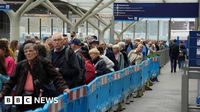Londoners have spent the past week navigating a city transformed by one of the most disruptive Tube strikes in recent memory. Now entering its fifth day as of September 11, 2025, the industrial action by thousands of Rail, Maritime and Transport (RMT) union members has not only paralyzed much of the Underground network but also sparked a remarkable surge in alternative modes of transport, from car rentals to e-bikes and beyond.
The roots of the dispute are familiar: RMT members are striking over pay and working hours, having rejected Transport for London’s (TfL) offer of a 3.4% pay increase. The union is also campaigning for a reduction in the 35-hour workweek, a demand TfL has called “impractical and absolutely unaffordable, with costs that could run into the hundreds of millions of pounds,” according to BBC and Fleet World. This standoff has left commuters scrambling for ways to get around, and the city’s response has been anything but predictable.
According to new data from Sixt, one of London’s largest rental firms, car rental bookings during the strike surged by as much as 140% in some locations compared to pre-strike levels. Andrew Smith, managing director of Sixt UK, told Fleet World, “Overall, reservations across affected locations have grown by 7%, and total reservation numbers are up to 45% higher than the same period last year. This mirrors trends we’ve observed during previous transport strikes, where demand for flexible and reliable mobility solutions spikes sharply.” Sixt responded by ensuring a full range of vehicles at key transport hubs like Victoria, King’s Cross, Heathrow, Marylebone, Liverpool Street, and London City Airport, and currently operates 16 branches within the M25.
But it’s not just car rentals that have seen a dramatic uptick. Ride-hailing platforms such as Bolt reported that trips to hospitals more than doubled between Monday and Wednesday of the strike week, with journeys to Guys and St Thomas’ Hospital up a staggering 118% compared to the previous week. Meanwhile, e-bike and e-scooter journeys via Lime soared during the morning commuter peak hours, jumping more than 50% over the first two days of the strike and reaching a 75% increase by Wednesday, according to BBC and Fleet World. The distances and durations of these journeys also rose, suggesting many Londoners were completing their entire commutes on two wheels.
YuLife, an employee benefits provider, revealed that cycling miles tracked across London jumped by 32% this week, rising from 3,878 to 5,120 miles. “A 32% rise in cycling shows how willing Londoners are to take their wellbeing into their own hands when given the nudge,” said Sammy Rubin, chief executive of YuLife, as cited by Fleet World.
The strike’s impact has not been limited to the Underground. The Docklands Light Railway (DLR) was also suspended on Tuesday, September 9, and Thursday, September 11, due to separate RMT industrial action, while bus services operated by First Bus face strike action from September 12 to 14, threatening to disrupt west, northwest, and southwest London. The cumulative effect has been a city forced to improvise—and in some cases, innovate.
Yet, for all the chaos, the strike’s disruption has been blunted by factors that simply didn’t exist a decade ago. Many office workers now have the option to work from home, and the Elizabeth line, which saw a 26% increase in passengers this week, has absorbed much of the displaced commuter traffic. London Overground usage is up 20%, and bus traffic has increased by 5%, according to London Centric’s reporting on TfL data. The Santander Cycle Hire scheme, meanwhile, is up a remarkable 93% week-on-week.
This pattern is not new. Research by Professor Shaun Larcom of the University of Cambridge, based on the 2014 Tube strike, found that about 5% of affected commuters permanently changed their route to work after being forced to experiment during the disruption. “A whole bunch of people were forced to experiment and a whole bunch of people seemed to find a better way to go to work,” Larcom told London Centric. The phenomenon, he explained, is driven by the high “search costs” of trying new routes—costs that are effectively waived during a strike when everyone is forced to adapt. Some even found their new commutes saved them time, suggesting that industrial action can inadvertently lead to lasting improvements in how Londoners get around.
The surge in e-bike usage has been particularly striking. At one point, a single Lime bike parking bay outside Bloomberg’s office on Queen Victoria Street reportedly held 415 Lime bikes and 35 Forest bikes, a testament to the sheer scale of the two-wheeled takeover. The debate over Lime bikes is heated: some Londoners grumble about blocked pavements and safety concerns, while others celebrate the reclaiming of city streets for cyclists. London Centric captured the mood in a quote from a local: “Normally I go into Waterloo and take the Waterloo and City line but now I’ve been walking and then catching a Lime bike halfway along to get here every morning. It’s been quite nice and refreshing.”
Politically, the strike is reshaping the landscape. With the impact of such actions increasingly diluted by flexible working and alternative transport, the unions’ leverage in negotiations may be waning. As London Centric noted, “If tube strikes no longer disrupt London as much as they used to then the threat of further industrial action will give unions less leverage in negotiations.” That’s a reality both TfL and the RMT are keenly aware of as talks continue.
The mechanics of the strike itself have added layers of complexity. The RMT staggered its action, with different groups striking on alternating days to maximize disruption while minimizing lost pay for workers. This led to some unexpected outcomes, such as Northern line trains running on Tuesday, September 9, due to the availability of non-union staff, and suburban stations being kept open with minimal staff while deep-level stations remained closed for safety reasons.
RMT general secretary Eddie Dempsey has been vocal in urging Mayor Sadiq Khan to get directly involved in resolving the dispute. On September 11, he called out Khan, saying, “Stop going on social media, invite us to the meeting, let’s have a discussion, because I want to know what is going on in London. We take no pleasure in causing disruption but we make no apology for fighting for our members. So if the mayor has any sense, he will reach out to us.” The mayor’s office responded, stating that Khan had “ensured TfL is ready to restart talks” with the union.
Meanwhile, the economic toll is mounting. The Centre for Economics and Business Research estimates the strikes will inflict a direct £230 million hit on London’s economy, with countless millions more in indirect impacts. Despite the high stakes, neither side appears ready to budge: the RMT hints it might settle for a half-hour reduction in working time as a first step, while TfL insists it cannot afford any further concessions.
As services are set to resume at 8:00 AM on Friday, September 12, with a good service expected on all lines by late morning, Londoners are left to ponder whether the city’s forced experiment in alternative commuting will leave a permanent mark. For some, the chaos has been an inconvenience; for others, an unexpected opportunity to rethink the daily grind. Either way, the week’s events have shown that even in the face of disruption, London’s resilience—and creativity—remain undimmed.


